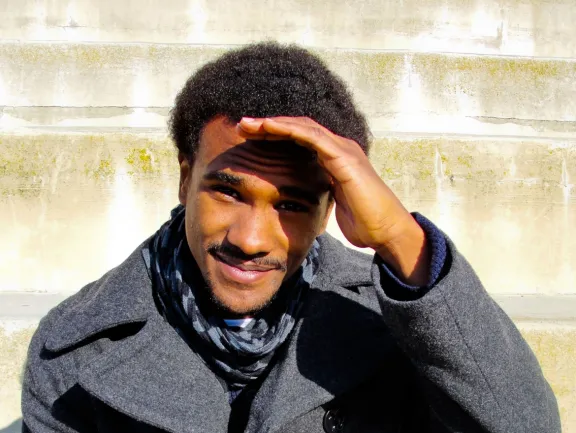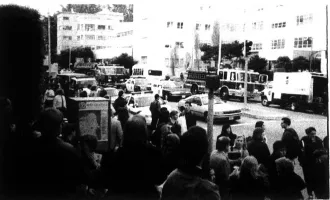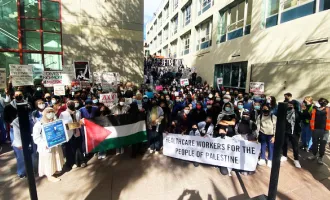
Student-Run Podcast Takes Science to the Airwaves
Connecting with the public has always been a challenge for scientists, especially when they are trying to motivate the next generation. Osama (Sama) Ahmed, a fifth-year UCSF neuroscience student, thinks he may have found the answer in Internet radio.
Since 2009, Ahmed has been quietly recording and producing Carry the One Radio (CTOR), a monthly podcast in which he and other graduate students interview investigators about their research and their motivations for pursuing careers in science. New shows are now featured on the Synapse website.
Recently, Ahmed has expanded his team to take the show to the next level, and last week, launched a Patreon (patreon.com/carrytheone) fund-raising drive. I sat down with him to learn more about how Carry the One Radio operates and where the show is headed.
Synapse: Can you tell me about your original motivation for starting Carry the One Radio?
Sama Ahmed: Initially, I wanted a way to expose students from under-represented backgrounds to how scientists think about their own work. But as the show progressed, I broadened my scope. The problem is, the public rarely has access to new scientific discoveries, since most top-tier journals place their publications behind pay walls.
Occasionally, a hot story is picked up by scientific news outlets and makes it into the mainstream press, but these articles don’t give you a good understanding of what it means to be a scientist or to do science. Our show tries to bring out the personal side of research by letting scientists speak directly to the public.
Synapse: Where did the name come from?
Sama Ahmed: The original inspiration for the name comes from a George Watsky poem about climate change called “Carry the One” (youtube.com/watch?v=lElMMsrI-z8).
I liked the mathematical reference, and the idea of passing the tradition of science to the next generation by carrying young students to a new level of understanding. To that end, one of our top priorities is to reach under-served high school students directly.
Synapse: How are you connecting with high school students?
Sama Ahmed: Some of our team members are interested in direct science-outreach and are using our interviews as inspiration for lesson plans that teachers can use in the classroom. These will be made freely available online.
Our first lesson was field-tested recently in a Los Angeles classroom. It is based on our interview with Dr. Cori Bargmann (Rockefeller University), who studies neuromodulators and how they control an animal’s behavior.
In the lesson, students take on the role of a brain cell that is transmitting a message to a neighboring brain cell. Other students act as neuromodulators that positively or negatively affect the message’s transmission. The students learn some biology and, more importantly, they design experiments that test how brain cells might communicate.
Our hope is to make Carry the One Radio a beacon for science education, one that serves as both a teaching tool and a bridge between scientists and the public.
Synapse: What is your workflow like? How do interviewees get chosen, and how does your team work together to produce the show?
Sama Ahmed: I’m a neuroscience student, so initially, many of our guests were neurobiologists whose work I was personally interested in. As our team grew, however, we expanded into other disciplines.
We currently have three regular hosts responsible for scheduling and conducting the interviews. The hosts are supported by a team of volunteers who help edit audio, manage the website and keep track of listener statistics, as well as create additional content, such as lesson plans and online material.
Synapse: What happens next? How much do you hope to grow CTOR?
Sama Ahmed: We want to do more than just one-on-one interviews, and we have recently started producing more topic-driven pieces in the style of This American Life or Radiolab. Our workflow for these spin-off episodes is very different.
We start with an idea that we want to tackle (e.g. a recent discovery, a current event or a story about scientists) and we gather hours of audio material, sounds and field interviews before putting it all together into a complete story. We’re very excited to be growing in this direction and to be learning about producing radio stories in the process.
We’re all volunteers, but expanding our project will take additional funds to buy better recording equipment, web hosting and more. To support the work, we’re running a Patreon campaign, which is a crowd-funding mechanism similar to Kickstarter, but better suited for serial projects like our monthly podcast.
Our patrons can pledge to donate a small amount each time we release an episode. Besides earning different material rewards, patrons can pitch ideas for new spinoff episodes, participate in the production process and see how things work behind the scenes.
Synapse: After producing more than 40 interviews, which one’s your favorite?
Sama Ahmed: One of my favorites would have to be Ed Chapman, who is a seriously cool guy. We started off talking about his work on how brain cells communicate, which quickly led to a conversation on using Botox in medicine.
I ended up having dinner with him and learning that we share similar tastes in documentaries. For me, the interactions I have with our guests before and after the interview are actually the most rewarding parts.
Synapse: Thanks for your time, and best of luck with the show!
Want to support Carry the One Radio? Consider donating to the show’s Patreon fund-raiser (http://www.patreon.com/carrytheone). You can also follow CTOR on Facebook (https://www.facebook.com/carrytheone), Twitter (@carrythe1radio) and on the web at http://www.carrytheoneradio.com.


